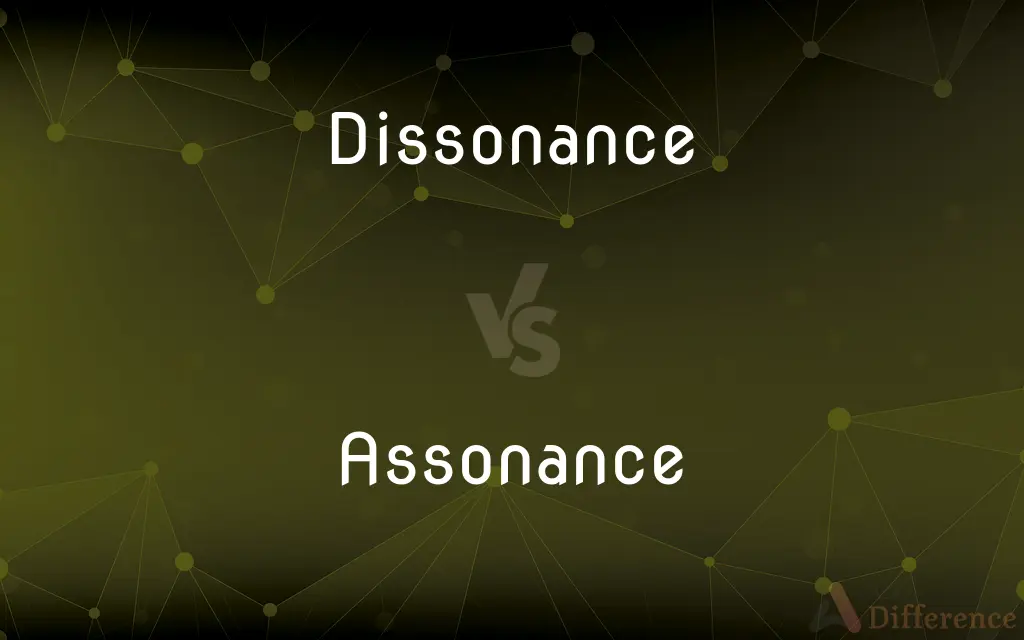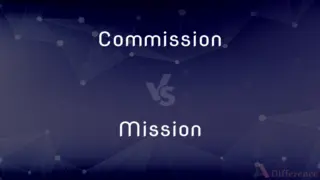Dissonance vs. Assonance — What's the Difference?
Edited by Tayyaba Rehman — By Urooj Arif — Updated on April 5, 2024
Dissonance creates a harsh sound by clashing consonants, while assonance involves the repetition of vowel sounds to create harmony.

Difference Between Dissonance and Assonance
Table of Contents
ADVERTISEMENT
Key Differences
Dissonance involves the use of clashing or harsh-sounding consonants within a passage, creating a sense of tension or discomfort in the listener or reader. On the other hand, assonance is characterized by the repetition of similar vowel sounds within a sentence or phrase, often used to create a harmonious and rhythmic effect that enhances the aesthetic quality of language.
While dissonance is often employed to evoke emotional responses or to highlight conflict within poetry, literature, or music, assonance serves to unify words and phrases, producing a soothing and pleasing sound that enhances the lyrical quality of a piece.
Dissonance can be found across various forms of art, including music, poetry, and prose, where it is used strategically to add depth and complexity to the emotional landscape of a work. Whereas assonance is particularly prevalent in poetry and song lyrics, where it contributes to the overall musicality and flow of the language.
In musical contexts, dissonance refers to the tension created by the combination of notes that traditionally "clash," leading to a feeling of unrest until resolved. Assonance, although more commonly associated with literary forms, can also relate to the harmony in music through repetitive patterns of sound that provide a sense of continuity and fluidity.
Dissonance is often utilized to challenge the audience’s expectations and evoke more profound contemplation or emotional response. In contrast, assonance tends to reinforce the thematic elements of a work and can aid in memorability or the creation of a particular mood.
ADVERTISEMENT
Comparison Chart
Definition
Clashing of harsh sounds to create tension.
Repetition of similar vowel sounds to create harmony.
Usage in Language
Used to evoke emotional response or highlight conflict.
Used to enhance lyrical quality and produce soothing sound.
Common Forms
Found in music, poetry, and prose.
Prevalent in poetry and song lyrics.
Emotional Effect
Creates tension, discomfort, or a sense of conflict.
Produces a harmonious, pleasing sound that enhances aesthetics.
Purpose in Composition
Adds depth and complexity; challenges expectations.
Reinforces thematic elements; aids in memorability and mood.
Compare with Definitions
Dissonance
Use in literature or music to evoke a specific emotional response.
The poet's use of dissonance in the final stanza mirrors the protagonist's turmoil.
Assonance
A resemblance of sounds in words or syllables.
The subtle assonance in the poem added to its musical quality.
Dissonance
Lack of agreement or harmony between people or things.
The dissonance among team members led to a failed project.
Assonance
Found in the repetition of similar vowel sounds within a sentence, phrase, or longer text.
The assonance in her speech added a lyrical quality to her delivery.
Dissonance
A tension or clash resulting from the combination of two disharmonious or unsuitable elements.
The dissonance between the movie's dark theme and its comedic elements was jarring.
Assonance
The repetition of the sound of a vowel or diphthong in non-rhyming stressed syllables.
The assonance in I lie down by the side of my bride fosters a soothing rhythm.
Dissonance
Psychological conflict resulting from incongruous beliefs and attitudes held simultaneously.
Cognitive dissonance forced him to reconsider his values.
Assonance
Technique for adding harmony and rhythm to poetry and prose.
He used assonance to enhance the poem's rhythmical pattern.
Dissonance
Lack of harmony among musical notes
A session full of jangling dissonances
An unusual degree of dissonance for such choral styles
Assonance
Literary device used to reinforce the meanings of words or to set the mood.
The assonance in the chorus makes the song catchy and memorable.
Dissonance
A harsh, disagreeable combination of sounds; discord.
Assonance
Assonance is a resemblance in the sounds of words/syllables either between their vowels (e.g., meat, bean) or between their consonants (e.g., keep, cape). However, assonance between consonants is generally called consonance in American usage.
Dissonance
Lack of agreement, consistency, or harmony; conflict
"In Vietnam, reality fell away and dissonance between claim and fact filled the void" (Michael Janeway).
Assonance
Resemblance of sound between syllables of nearby words, arising particularly from the rhyming of two or more stressed vowels, but not consonants (e.g. sonnet, porridge), but also from the use of identical consonants with different vowels (e.g. killed, cold, culled)
Alliterative assonances such as ‘fail’ and ‘fall’ are very common in Old English poetry
The use of assonance throughout the poem creates the sound of despair
Dissonance
(Music) A combination of tones contextually considered to suggest unrelieved tension and require resolution.
Assonance
Resemblance of sound, especially of the vowel sounds in words, as in
"that dolphin-torn, that gong-tormented sea" (William Butler Yeats).
Dissonance
A harsh, discordant combination of sounds.
Assonance
The repetition of identical or similar vowel sounds, especially in stressed syllables, with changes in the intervening consonants, as in the phrase tilting at windmills.
Dissonance
(music) Conflicting notes that are not overtones of the note or chord sounding.
Assonance
Rough similarity; approximate agreement.
Dissonance
A state of disagreement or conflict.
Assonance
(prosody) The repetition of similar or identical vowel sounds (though with different consonants), usually in literature or poetry.
Dissonance
(countable) An instance of disharmony or disjunction; a clash.
Assonance
Resemblance of sound.
Dissonance
A mingling of discordant sounds; an inharmonious combination of sounds; discord.
Filled the air with barbarous dissonance.
Assonance
A peculiar species of rhyme, in which the last accented vowel and those which follow it in one word correspond in sound with the vowels of another word, while the consonants of the two words are unlike in sound; as, calamo and platano, baby and chary.
The assonance is peculiar to the Spaniard.
Dissonance
Want of agreement; incongruity.
Assonance
Incomplete correspondence.
Assonance between facts seemingly remote.
Dissonance
A conflict of people's opinions or actions or characters
Assonance
The repetition of similar vowels in the stressed syllables of successive words
Dissonance
The auditory experience of sound that lacks musical quality; sound that is a disagreeable auditory experience;
Modern music is just noise to me
Dissonance
Disagreeable sounds
Common Curiosities
Can dissonance be used positively?
Yes, dissonance can be used to add emotional depth, highlight conflict, or provoke thought in an artistic composition.
How does assonance enhance poetry?
Assonance adds musicality, rhythm, and harmony to poetry, making it more pleasing to the ear and memorable.
What is dissonance?
Dissonance refers to a harsh, discordant combination of sounds, often used in music and literature to evoke tension or conflict.
What is assonance?
Assonance is the repetition of vowel sounds in closely placed words, used to create a harmonious effect in poetry and prose.
How does dissonance affect music?
In music, dissonance creates tension and a sense of unease, which is often resolved with consonance, leading to a satisfying resolution.
Is assonance only found in poetry?
While assonance is most common in poetry, it is also used in prose and song lyrics to create rhythm and harmony.
Can dissonance be used in visual arts?
Yes, visual arts can employ dissonance through contrasting colors, shapes, or themes to evoke a sense of tension or conflict.
How do writers use assonance effectively?
Writers use assonance to emphasize certain ideas, add rhythm and fluidity to their text, and create a particular mood or tone.
How do dissonance and assonance differ in purpose?
Dissonance aims to evoke tension or highlight conflict, while assonance aims to create harmony and enhance aesthetic pleasure.
How can dissonance be resolved in music?
Dissonance in music is typically resolved by moving to a consonant chord, which provides a sense of release and satisfaction.
What effect does assonance have on readers or listeners?
Assonance can make text or music more engaging and enjoyable by adding a lyrical quality and enhancing its sound.
Does dissonance always indicate conflict?
In literature and music, dissonance often signifies conflict or tension, but it can also add complexity and richness to the composition.
Can assonance affect the mood of a piece?
Yes, assonance can significantly affect the mood of a piece, creating a soothing, uplifting, or otherwise harmonious atmosphere.
Are dissonance and assonance mutually exclusive?
No, both dissonance and assonance can be used within the same piece to create a complex interplay of tension and harmony.
What distinguishes dissonance from cacophony?
Dissonance refers specifically to tension-creating sounds, while cacophony describes any harsh, discordant mixture of sounds, not necessarily with an underlying tension or purpose.
Share Your Discovery

Previous Comparison
Commission vs. Mission
Next Comparison
Gastropod vs. MolluskAuthor Spotlight
Written by
Urooj ArifUrooj is a skilled content writer at Ask Difference, known for her exceptional ability to simplify complex topics into engaging and informative content. With a passion for research and a flair for clear, concise writing, she consistently delivers articles that resonate with our diverse audience.
Edited by
Tayyaba RehmanTayyaba Rehman is a distinguished writer, currently serving as a primary contributor to askdifference.com. As a researcher in semantics and etymology, Tayyaba's passion for the complexity of languages and their distinctions has found a perfect home on the platform. Tayyaba delves into the intricacies of language, distinguishing between commonly confused words and phrases, thereby providing clarity for readers worldwide.
















































